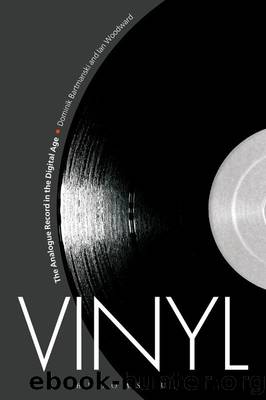Vinyl (Criminal Practice Series) by Dominik Bartmanski & Ian Woodward

Author:Dominik Bartmanski & Ian Woodward [Bartmanski, Dominik]
Language: eng
Format: epub
ISBN: 9780857856586
Publisher: Bloomsbury Publishing
Published: 2015-01-29T06:00:00+00:00
FIGURE 3.4: Iconic Ortofon Concorde pickup. (DB)
In short, a given technological network like the one briefly described here is at once a phenomenological nexus and a carefully calibrated chain of devices which form a unique chain of interconnected entities. The complex of embodied knowledge, repeated practices and sheer fun associated with those things gives rise to a distinct sensory formation irreducible to the way we talk about it and independent from the musical content for which it is created. The virtual environment in which new miracles of technology like Ableton thrive is also such a sensory formation. When Marshall McLuhan spoke of the Gutenberg galaxy, he may have meant something like sensory formation too.
Crucially, failure of the playing machine, or its temporary absence or shortage, introduces a Heideggerian displacement that makes us more aware of the equipmentâs role and thus its value. However, it does not mean the destruction of the music medium itself. This may not be the case with files whose very existence and functionality depend on computers and integrity of hardware. As digital music consumption evolves away from object-ownership towards streaming and similar services, analogue record re-emerges as the principal offline medium. Some record stores self-consciously emphasize this; for example, Hardwax attaches special stickers âofflineâstore onlyâ to its exclusive merchandise. Various electronic music labels subscribe to this trend, releasing âstore-only seriesâ, for example Rotterdam-based Clone Records. The limited batch is then distributed to befriended physical shops whose owners sign the centre label of each item under the generic rubric: âlocationâ. Peter Runge once again mischievously observes that vinylâs offline character makes you invisible to any government or company as long as you donât pay for it with a credit card. An interesting paradox is that the most tactile and visual mediumâs use can most reliably be concealed. Since many independent record stores â as we shall note later â work outside electronic cash systems, they indeed become a paradigmatically offline and potentially subversive cultural institution. Vinyl resists easy homologation, once again. In short, vinylâs technological entanglements are integral to vinylâs sensory enjoyment, but their failure is not sufficient to deprive us of the medium itself. It is the very physicality of records as things that makes them special.
VINYL AS THING
Each way of accessing recorded music is a distinct mode of engagement with it that often gives as much as it takes away. The question is what it is that you want or need, rather than what constitutes âprogressâ. There is genuine science and profound art to making and playing vinyl. It is a thing of immersive qualities despite its simplicity. We can certainly say that new digital technologies like Ableton are immersive but it does not mean the same and they are all but simple. The actual meaning of a thing comes from a constellation of experiences and the specific sensory formation to which it belongs and within which it performs its function. There is no absolute scale that would enable us to say: this is better. But thatâs hardly a problem.
Download
This site does not store any files on its server. We only index and link to content provided by other sites. Please contact the content providers to delete copyright contents if any and email us, we'll remove relevant links or contents immediately.
Kathy Andrews Collection by Kathy Andrews(11730)
The remains of the day by Kazuo Ishiguro(8823)
Paper Towns by Green John(5091)
Spare by Prince Harry The Duke of Sussex(5072)
Industrial Automation from Scratch: A hands-on guide to using sensors, actuators, PLCs, HMIs, and SCADA to automate industrial processes by Olushola Akande(4982)
The Body: A Guide for Occupants by Bill Bryson(4974)
Machine Learning at Scale with H2O by Gregory Keys | David Whiting(4183)
Be in a Treehouse by Pete Nelson(3948)
Never by Ken Follett(3791)
Harry Potter and the Goblet Of Fire by J.K. Rowling(3775)
Goodbye Paradise(3728)
Into Thin Air by Jon Krakauer(3313)
The Remains of the Day by Kazuo Ishiguro(3293)
The Cellar by Natasha Preston(3262)
The Genius of Japanese Carpentry by Azby Brown(3224)
Fairy Tale by Stephen King(3220)
120 Days of Sodom by Marquis de Sade(3182)
The Man Who Died Twice by Richard Osman(2997)
Drawing Shortcuts: Developing Quick Drawing Skills Using Today's Technology by Leggitt Jim(2996)
